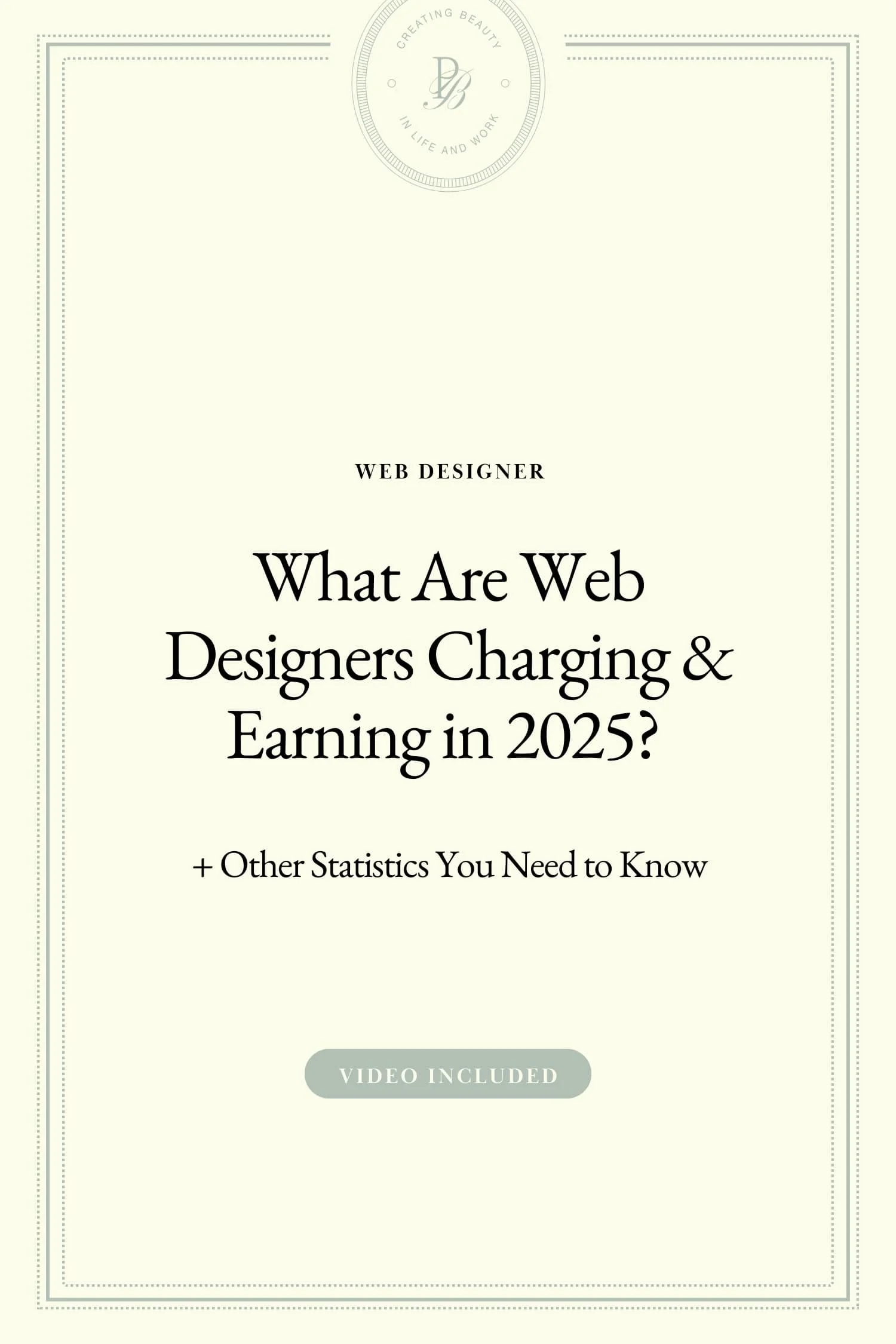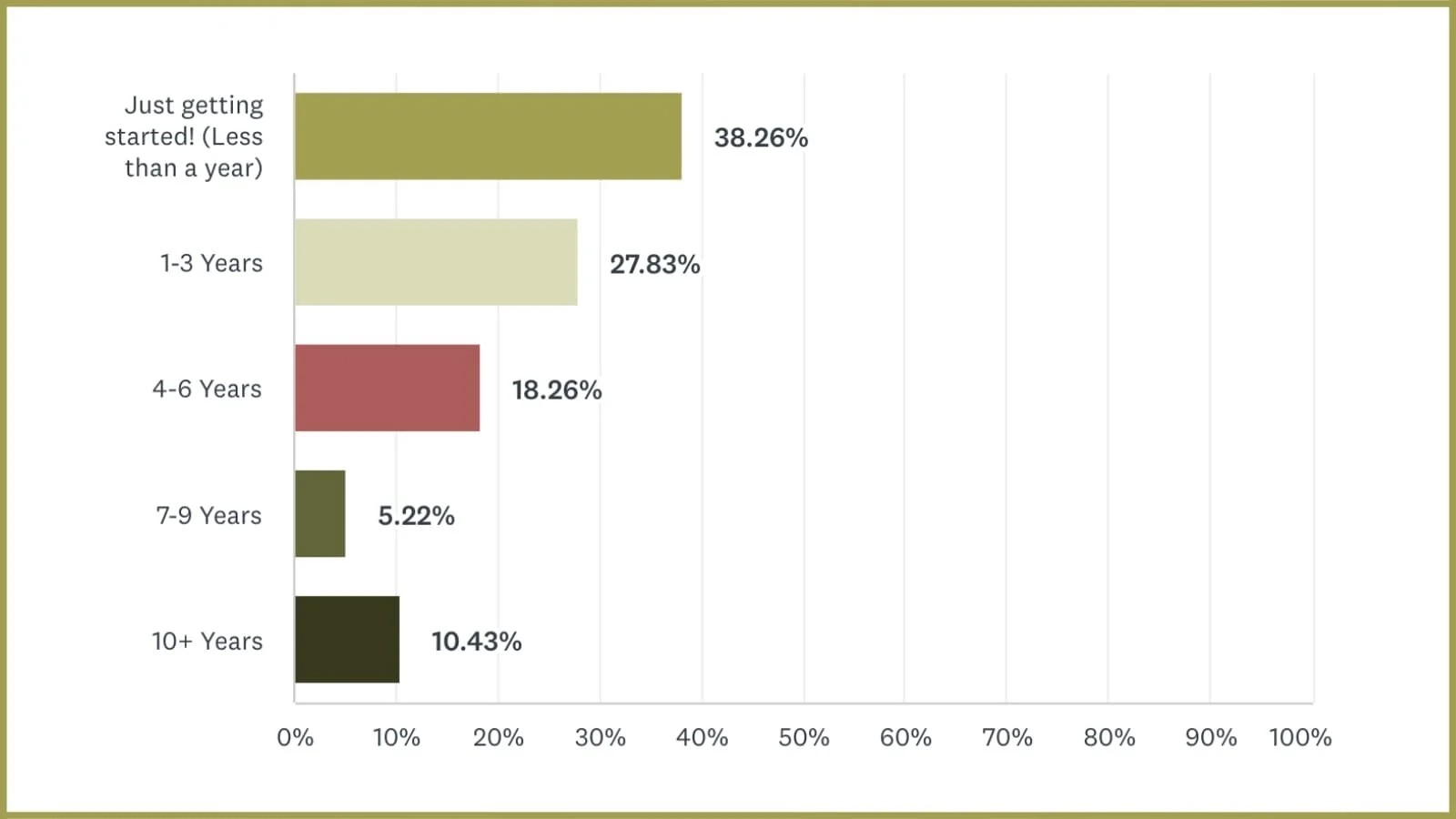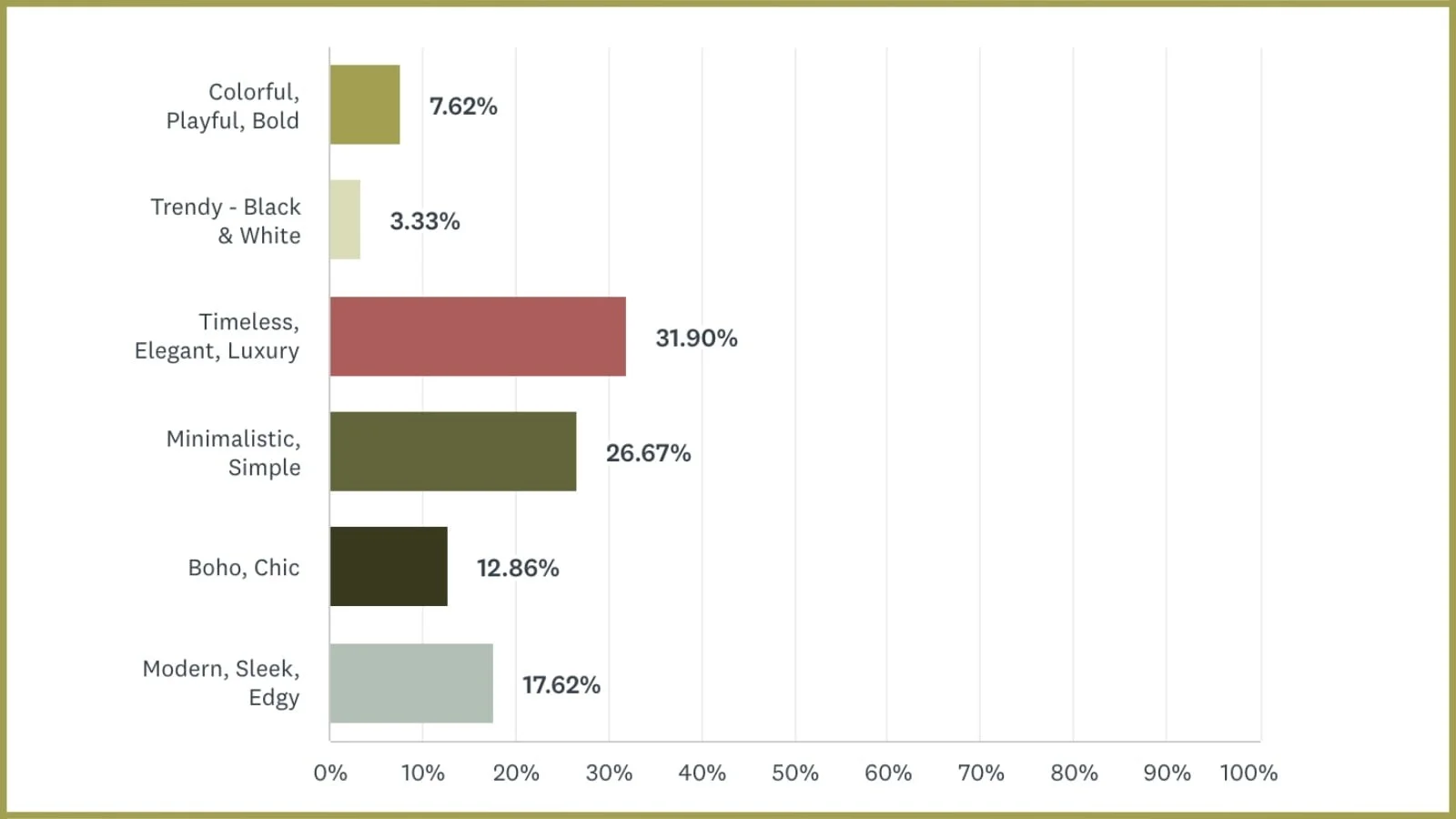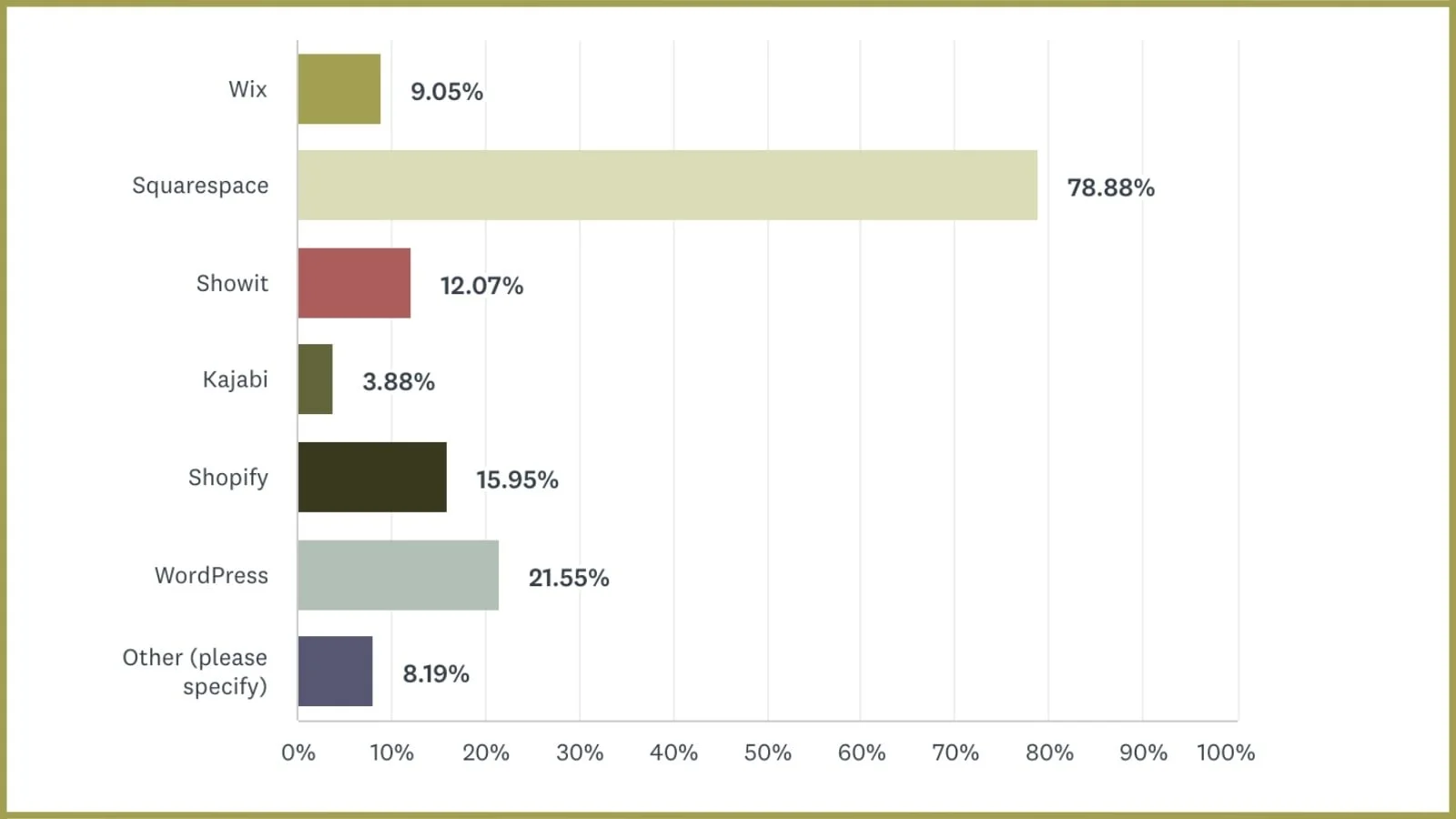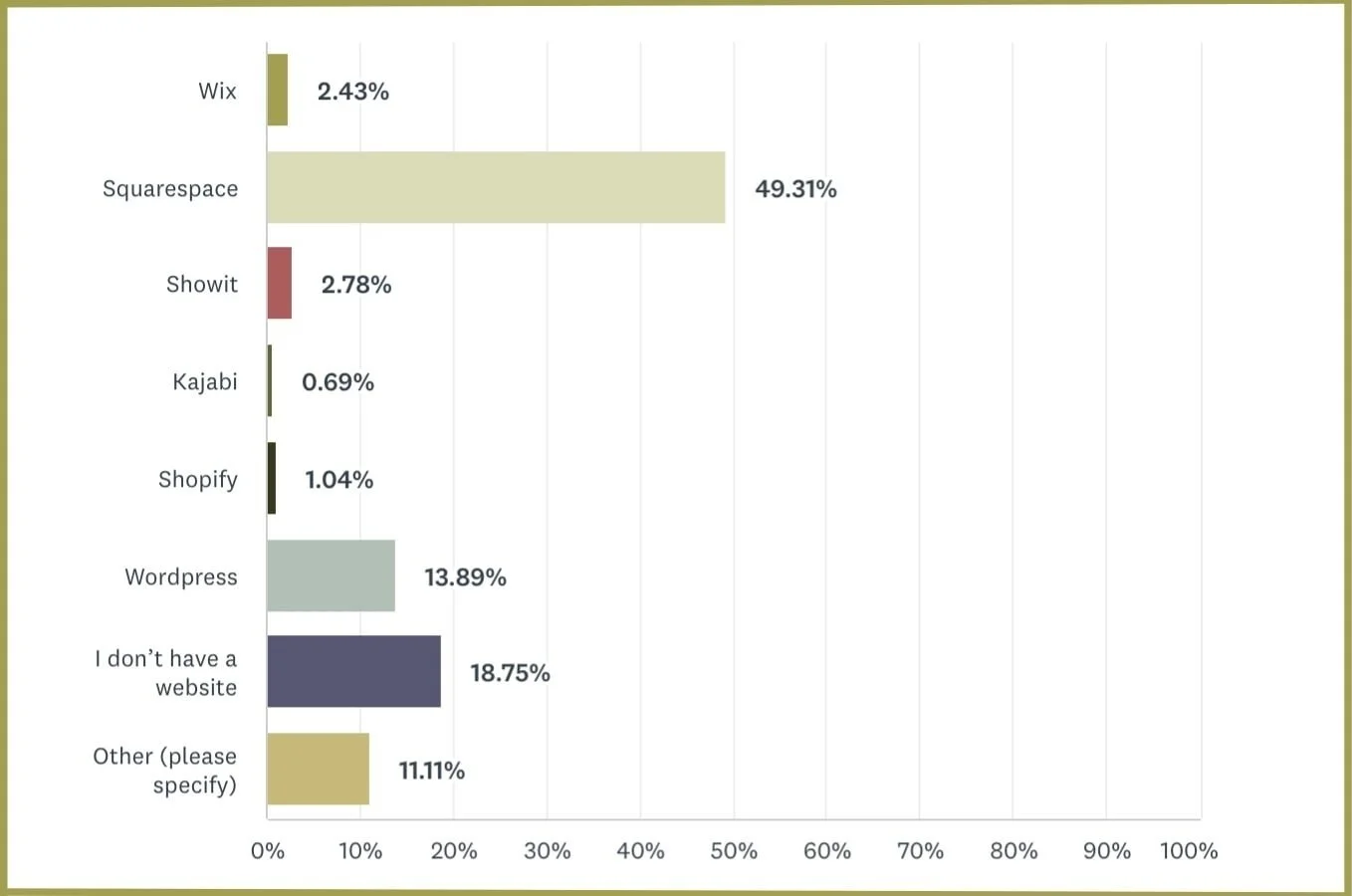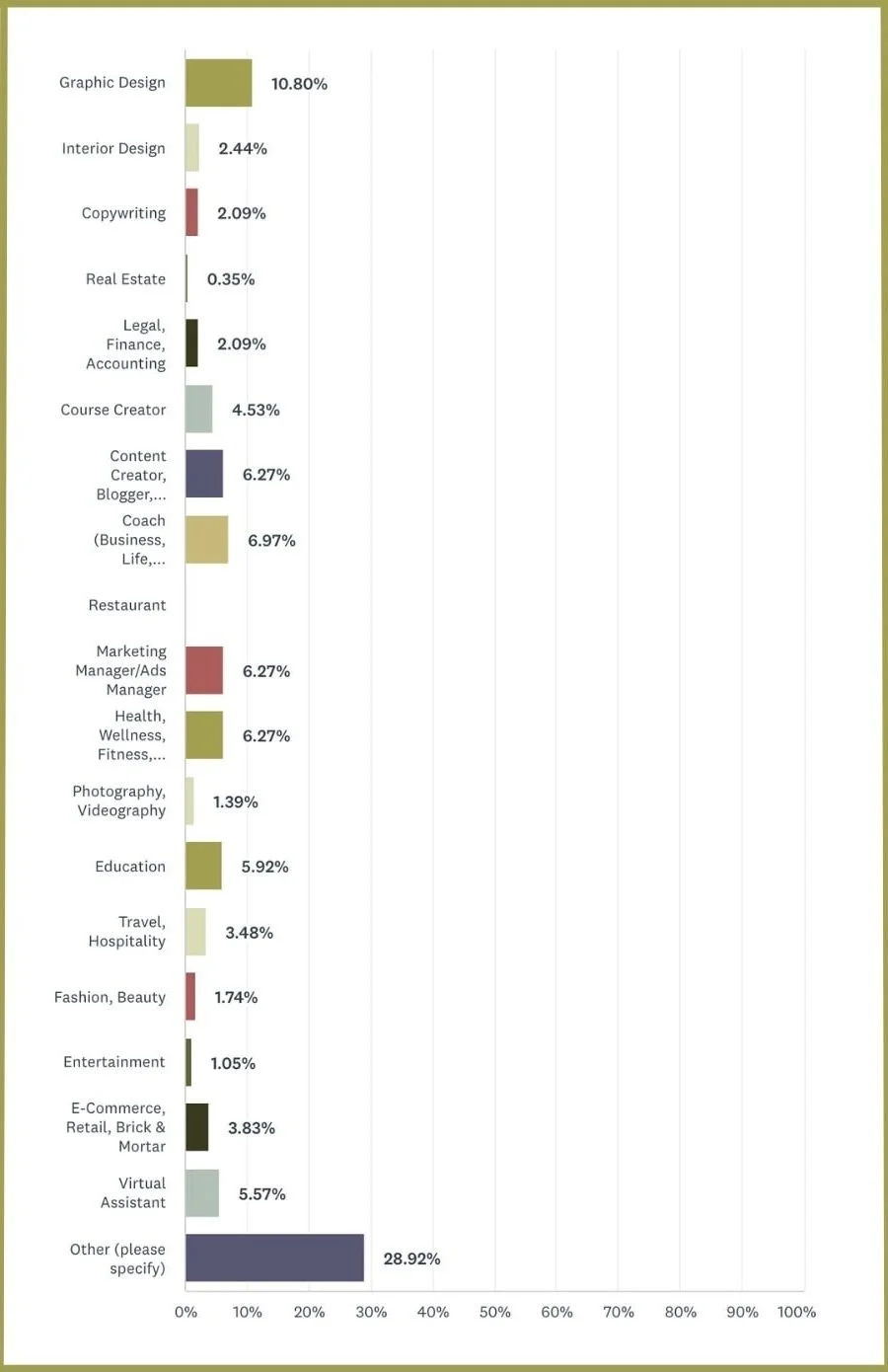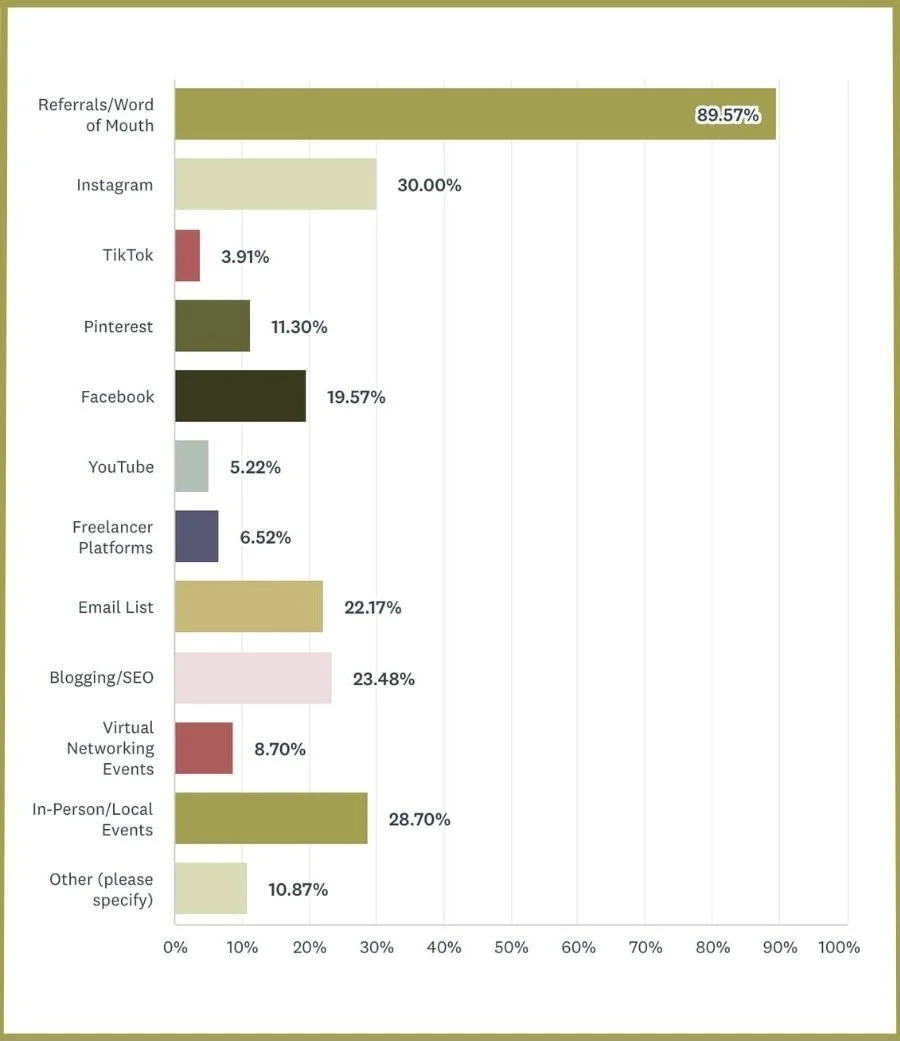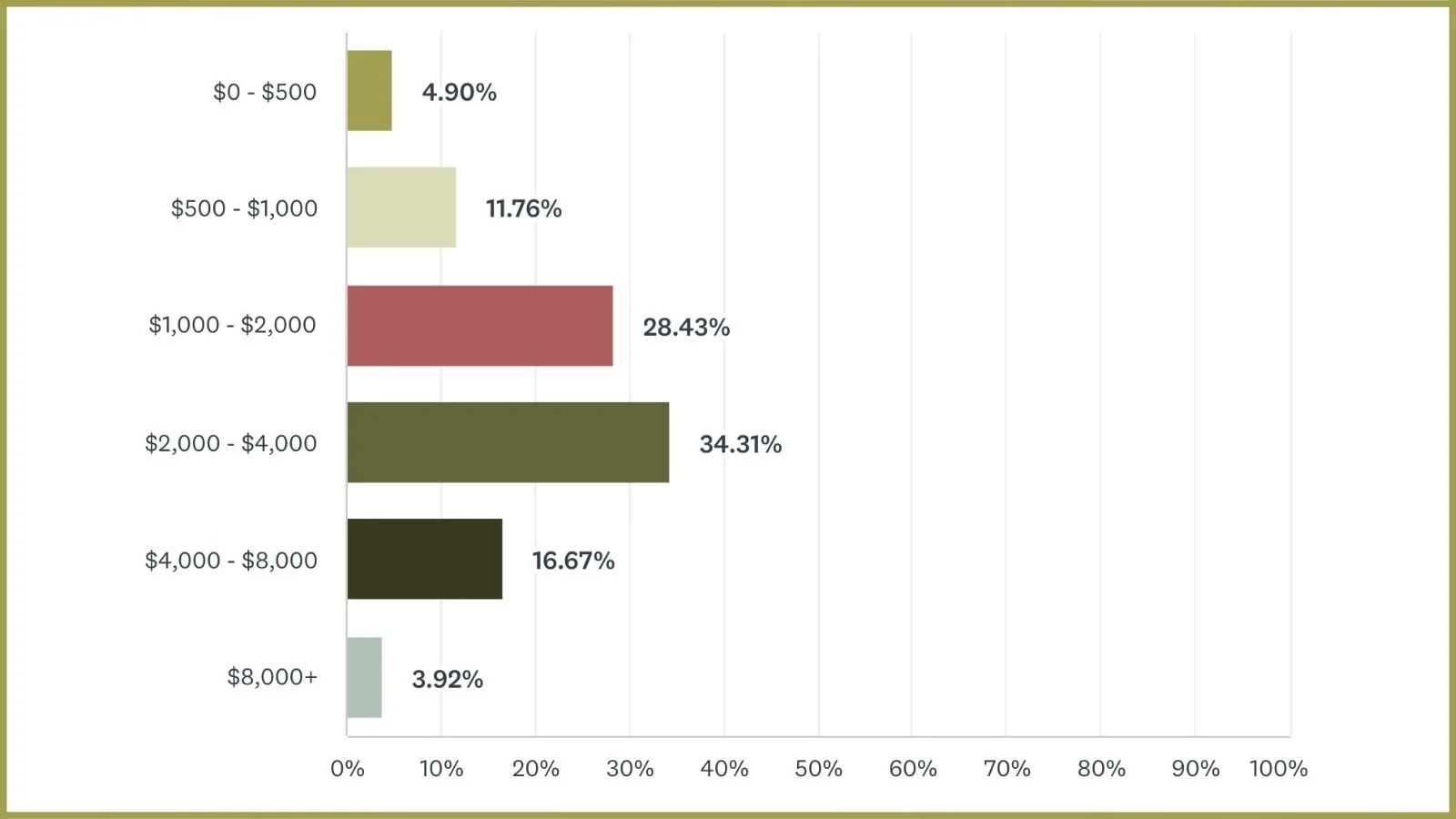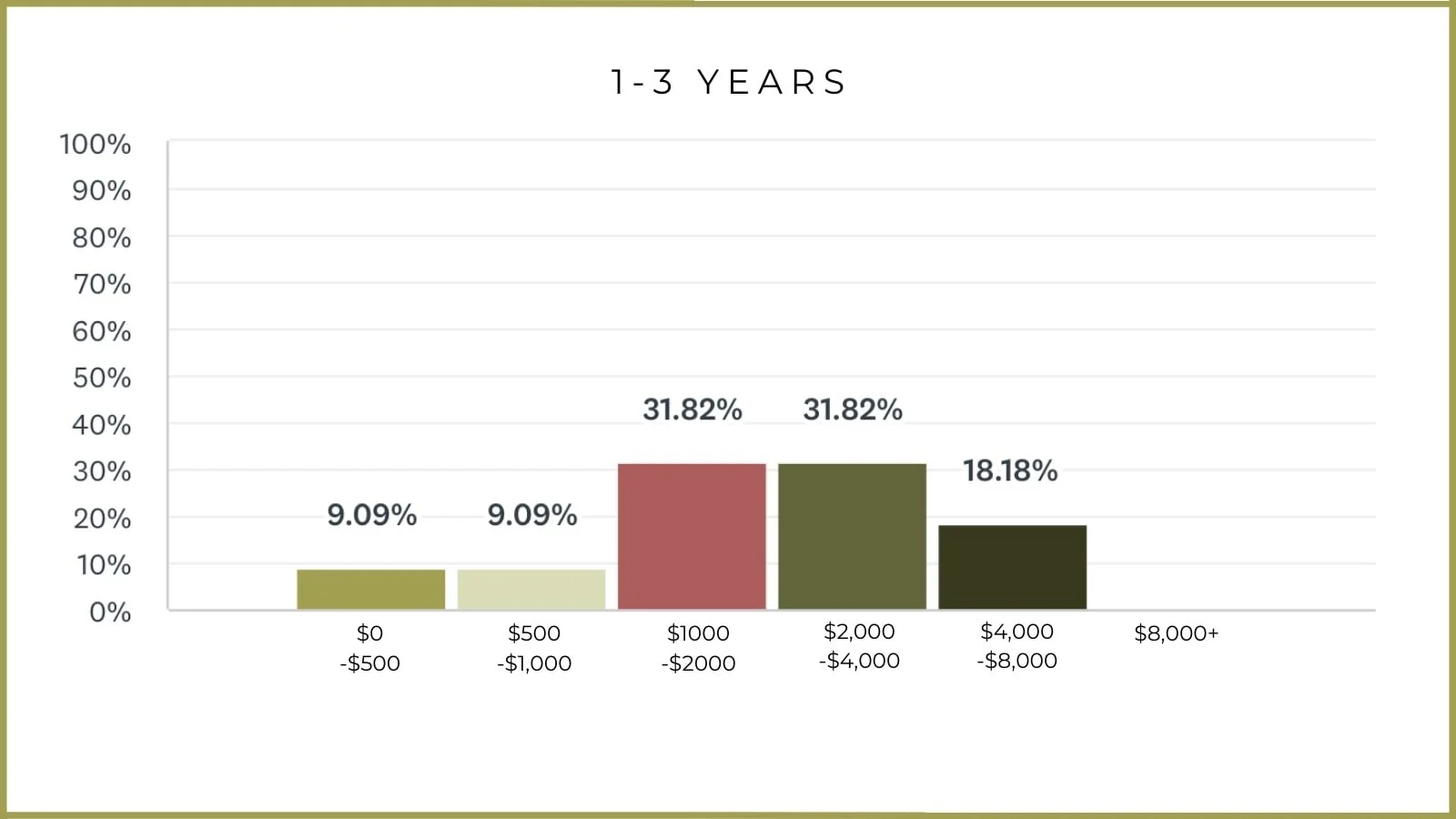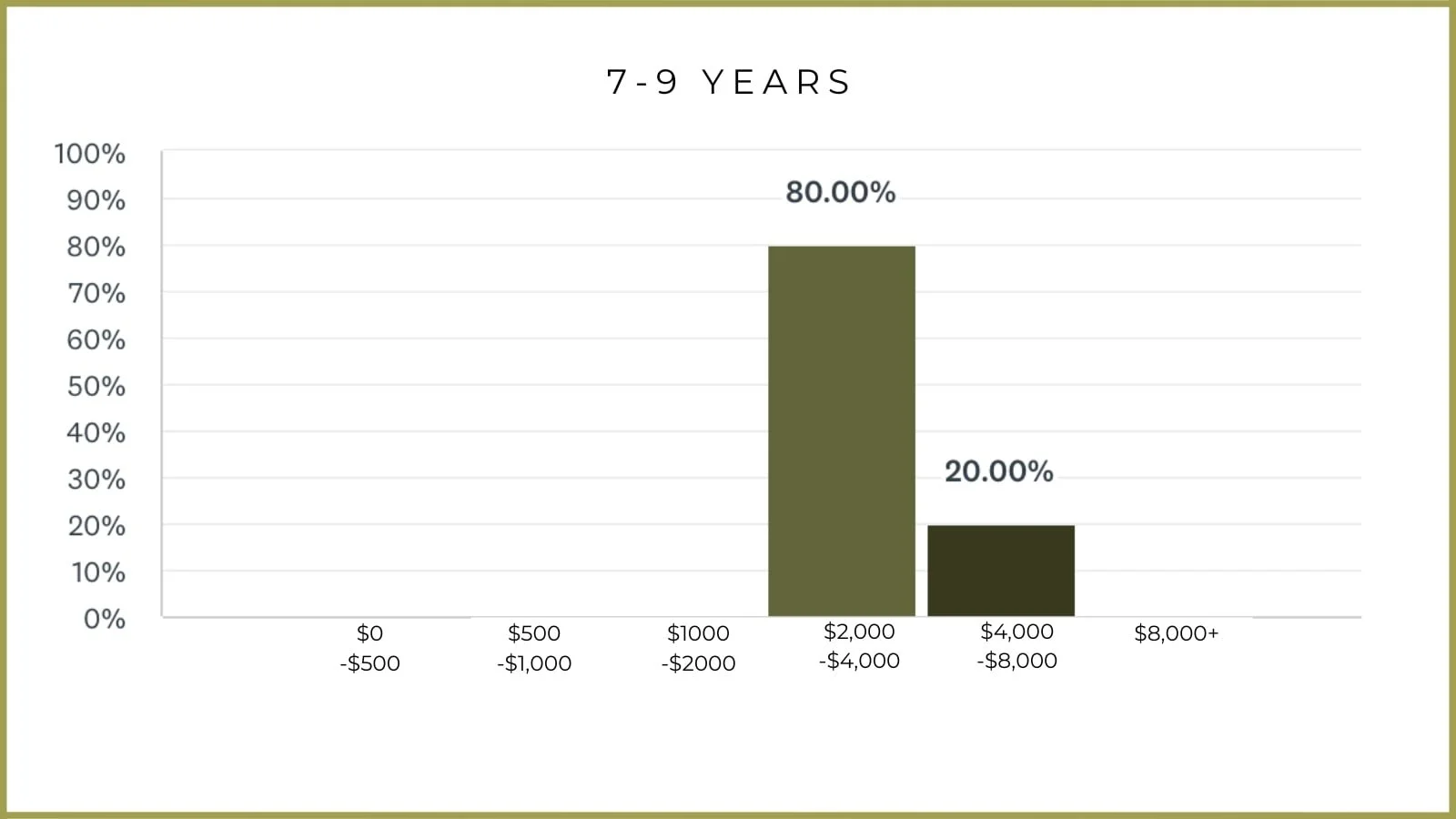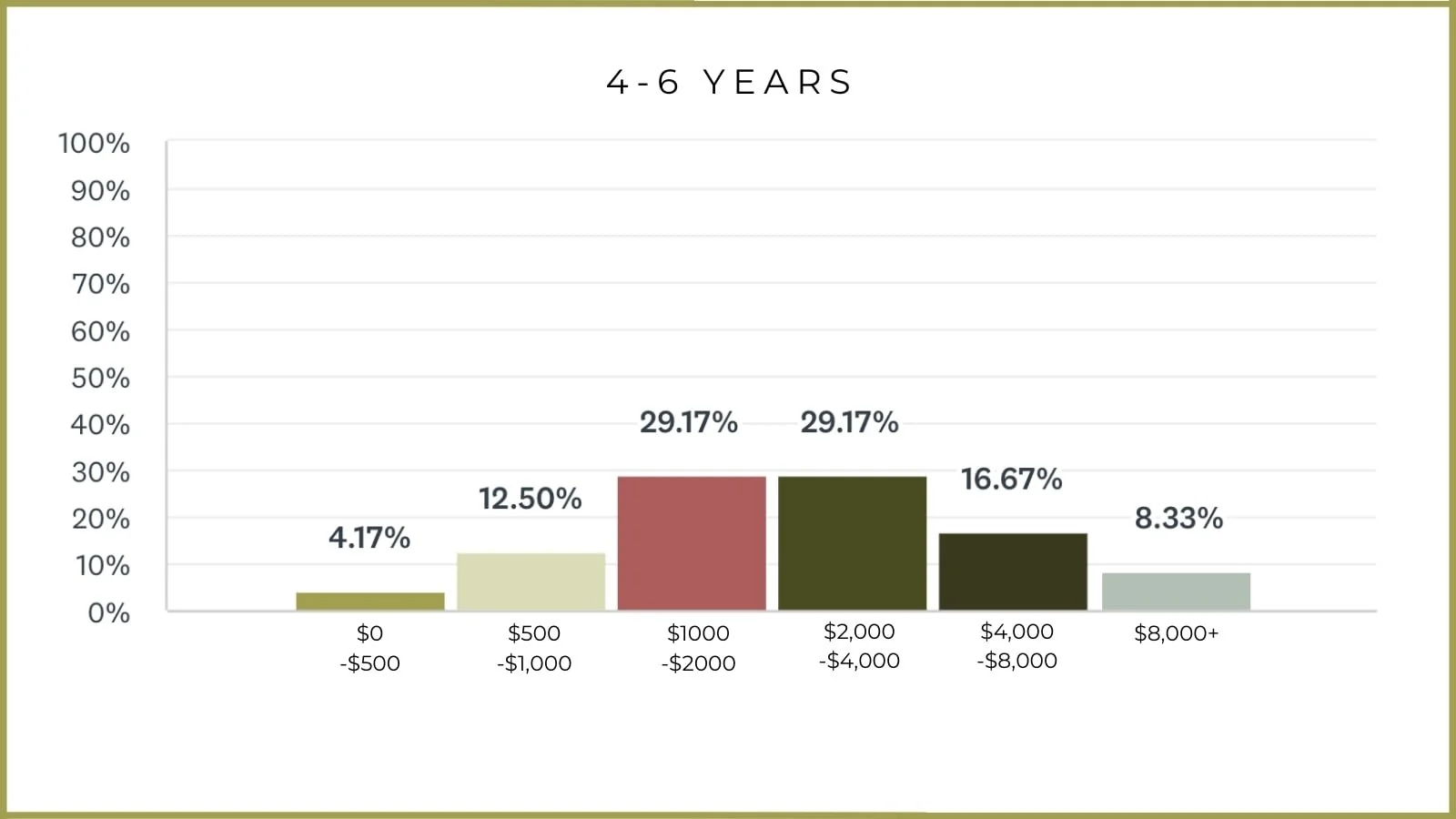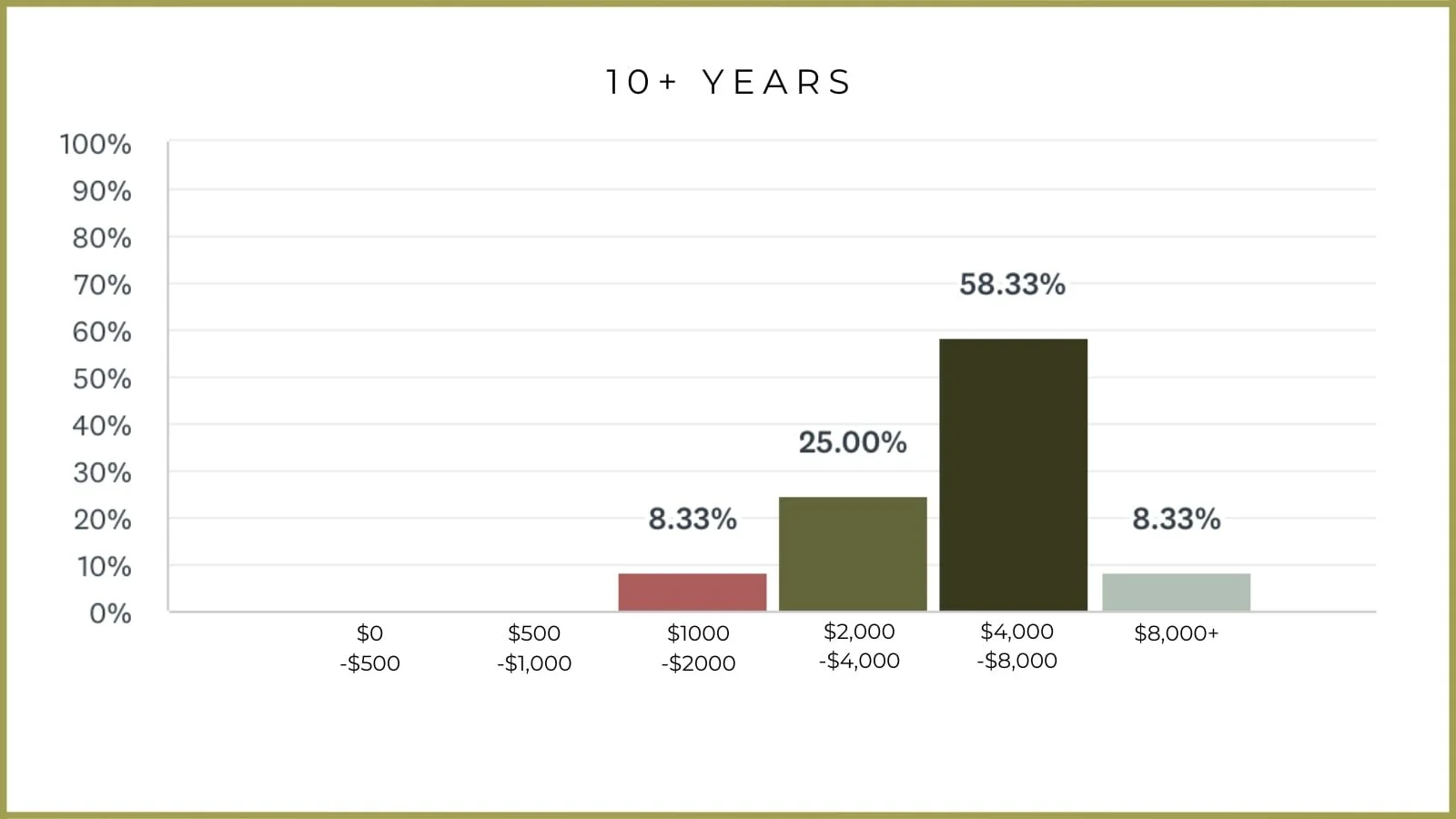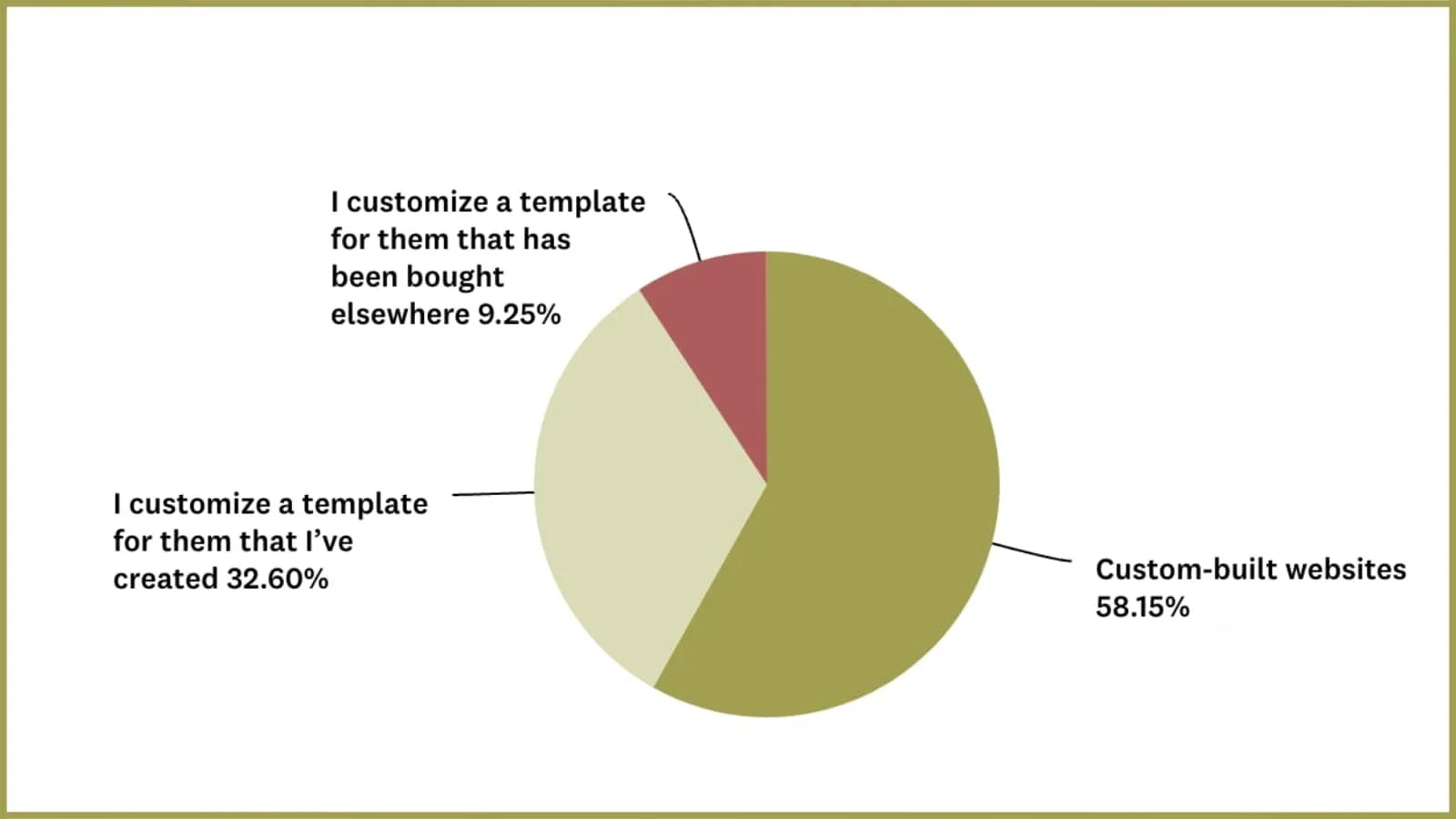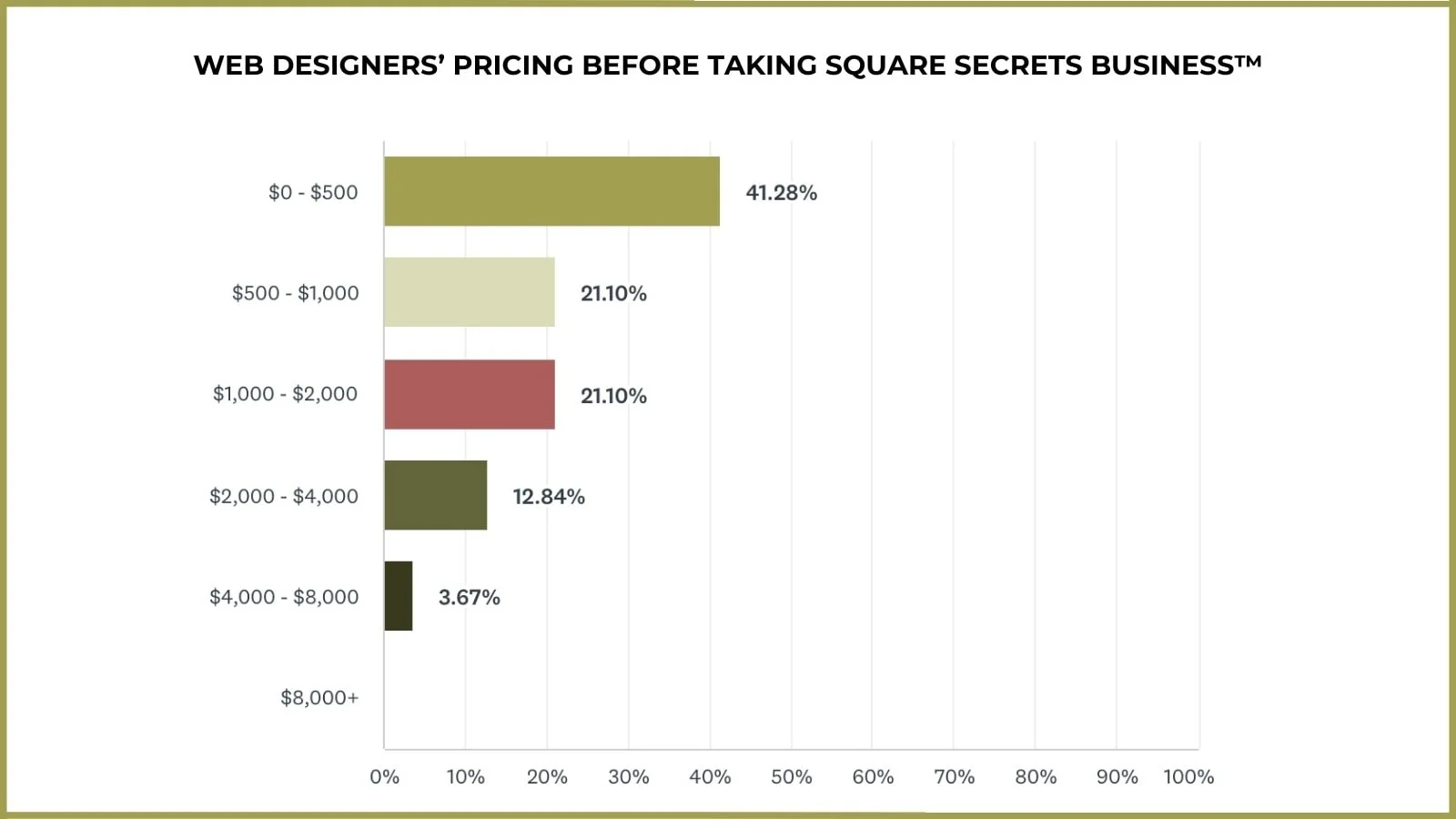What Are Web Designers Charging & Earning in 2025? + Other Statistics You Need to Know
Mentioned in the POST:
*Yup - that’s an affiliate link! My margarita fund thanks you kindly!
How Much Are Web Designers Charging in 2025?
Are custom-built sites being edged out by templates?
Is the Square Secrets Business™ course really worth the investment?
If you’re curious about any of these questions, you’re in the right place.
My last survey was back in the spring of 2022 (take a peek here if you’re curious!), and with so much having changed since then, it felt like the perfect moment for a refresh.
This time, I went deeper, gathering insights from a diverse group of 500+ participants—a mix of talented web designers, entrepreneurs, and aspiring business owners dreaming of saying goodbye to their 9-to-5 jobs this year.
The result? A treasure trove of insights that offer plenty of aha moments, actionable takeaways, and a fresh perspective on the industry today.
I also had the chance to connect with many of my Square Secrets Business™ students to uncover the measurable impact the course has had on their careers.
Spoiler: the results are as exciting as they are heartwarming (cue a little happy tear over here).
From the hurdles designers are facing to pricing strategies, client niches, and the design trends shaping 2025, this survey has everything you need to navigate—and thrive—in this ever-evolving space.
Whether you’re a fresh-faced designer eager to make your mark or a seasoned pro looking for renewed inspiration, there’s something here just for you.
So, pour yourself a cozy coffee (or perhaps a sparkling glass of something celebratory—I won’t judge), and let’s dive into the results together.
Experience & Education: Web Design Today
How long ago did you start your web design business?
We asked, “How long ago did you start your web design business?” and the results are in: nearly 90% of web designers surveyed have been at this for less than 10 years. Why? Because until recently, the tools needed to create custom websites—without a computer science degree—simply didn’t exist.
A decade or two ago, web development was more of an elite club than an accessible career. Joining meant dedicating years to coding, often with a formal degree as your golden ticket. 👩🎓
But even then, web developers weren’t crafting sleek sites for the neighborhood coffee shop or trendy boutique. Their focus? Mega-corporations like Google, Microsoft, and Apple. Small businesses were just beginning to realize that “www.” wasn’t just a weird prefix in commercials.
So, what’s changed?
Everything.
The past decade has completely redefined the industry. Platforms like Squarespace and Wix, alongside other web design tools, have transformed the field, opening doors for creatives everywhere. And the best part? You don’t need a coding background or years of experience to get started.
If you’re just stepping into web design and wondering if you’ve missed the boat, let me assure you: you’re right on time.
Here’s why this is your moment:
Better Tools: Today’s platforms are intuitive, powerful, and full of possibilities. Drag-and-drop interfaces and polished templates give you a head start designers from a decade ago couldn’t have imagined.
Endless Clients: Businesses now understand that a website isn’t a nice-to-have; it’s a must. From local shops to online entrepreneurs, there’s a growing market ready to invest in their digital presence—and in someone like you.
Freedom & Flexibility: Unlike the 9-to-5 grind of the past, today’s web design world offers lifestyle freedom. Whether you’re working from your couch, a cute café, or a sunlit terrace overlooking the Italian countryside, the choice is yours.
The takeaway?
It’s never too late to join the world of web design. The tools, opportunities, and lifestyle perks have never been better, and now is your chance to step into an industry that’s still growing, evolving, and full of potential.
So, go ahead, grab your metaphorical (or literal) party hat, and dive in—you’re arriving just as things are getting good.
Web Design Styles: What’s Trending in 2025?
When we asked web designers about their favorite design styles, the results painted a picture as intricate and varied as a gallery at the Louvre. From timeless classics to bold new trends, here’s what’s making waves this year:
31.25% crowned Timeless, Elegant, Luxury as their top choice—a refined favorite that never goes out of style.
26.92% embraced Minimalistic, Simple designs, proving that sometimes less isn’t just more—it’s everything.
17.79% leaned toward Modern, Sleek, Edgy styles, the perfect pairing for tech-forward and innovative industries.
12.98% gravitated to Boho, Chic vibes, a cozy blend of creativity and warmth.
7.69% went bold with Colorful, Playful, Bold designs—an aesthetic with personality to spare.
3.37% favored the stark contrast of a Trendy Black & White palette, balancing drama and minimalism.
We also asked potential clients about their preferences, and the results spoke volumes: Timeless, Elegant, Luxury came out on top again, this time with an even more commanding 43.55%, while Minimalistic, Simple slipped slightly to 18.12%.
What These Results Mean
Timeless, Elegant, Luxury
This style is the belle of the ball in 2025, and for good reason. Its sophistication and poise make it the perfect match for high-end industries like fashion, real estate, and hospitality. Think of it as the design equivalent of a made-to-measure Italian suit: timeless, impeccably crafted, and worth the investment. For designers aspiring to the upper echelons of the industry, this is your opportunity to shine.
Minimalistic, Simple
A perennial favorite, minimalism is as reliable as a perfectly brewed espresso in Milan. Clean lines, understated elegance, and a focus on functionality make it a go-to across industries. And while trends come and go, minimalism has proven time and again that it’s here to stay.
Bold Colors & Playful Designs
Vivid and full of life, bold designs are making a comeback in 2025. But pulling them off is no walk in the park—it’s more like navigating a five-course Michelin-starred menu. To master this aesthetic, you’ll need an experienced eye and a strong grasp of color theory. Feeling confident? This style could help you stand out like a bright red Strathberry bag in a sea of neutrals.
Pro Tip: Want to learn how to nail bold colors or elevate minimalism? Check out my YouTube video where I reveal the secret to choosing fabulous color pairings for your website!
Modern, Sleek, Edgy
Polished, forward-thinking, and professional, this style is a natural fit for clients in tech and start-ups. It’s as much about innovation as it is about style, making it a versatile choice for designers who want to stay ahead of the curve.
Boho, Chic & Trendy Black & White
These niche styles offer something unique for specific audiences. Boho, Chic vibes are perfect for creatives and small businesses craving warmth and individuality—like a cozy Sézane sweater on a crisp fall day. Meanwhile, Black & White is a minimalist’s dream, delivering bold, high-contrast drama with a modern edge.
Which Web Design Platforms Are Designers Using in 2025?
It’s hardly a surprise that Squarespace emerged as the clear favorite in our survey, with a remarkable 78.70% of respondents choosing it as their primary platform.
So, what makes Squarespace such a standout choice?
Client-Friendly Features: Post-launch, clients can manage and update their sites effortlessly—no coding bootcamp required.
All-in-One Functionality: With blogging, e-commerce, and SEO tools built right in, there’s no need to wrestle with an endless array of plugins or third-party tools.
Designer Versatility: For web designers, Squarespace strikes the perfect balance between ease of use and creative freedom. It allows for completely custom, polished, and nothing-like-the-template websites—all without writing a single line of code.
As a designer who specializes in Squarespace, it’s no shock that many of the survey participants from my audience are also devoted Squarespace enthusiasts.
The Other Contenders
While Squarespace dominated, a handful of other platforms also made a strong showing:
WordPress claimed second place at 21.74%
Shopify followed at 15.65%, the go-to platform for e-commerce-heavy clients.
Showit landed at 12.17%
Wix and Kajabi rounded out the results at 8.70% and 3.91%, respectively.
Does This Reflect Client Preferences?
Interestingly, this preference for Squarespace also seems to align with what clients want. According to the survey, 49% of potential clients were already using Squarespace for their own websites.
This synergy between designer and client preferences underscores why Squarespace remains such a dominant force in the web design space.
That said, it’s worth noting that the results likely carry a touch of bias—after all, this survey was conducted with my audience, and let’s just say I have a fair few Squarespace fans in my circle!
What niches are web designers serving in 2025?
When it comes to attracting consistent, high-paying clients, the advice is simple yet powerful: niching down is key.
Focusing on a specific audience not only helps you stand out but also allows you to become the expert clients trust and turn to—like the perfectly tailored Chanel suit of web design.
So, what niches are web designers focusing on?
Here’s a closer look at the results from our survey—a curated collection of inspiration to help you find the niche that fits your talents and ambitions like a glove.
The Big Earners: High-Value Niches
We also explored which industries bring in the most revenue for web designers—particularly those commanding $8,000+ per project. Unsurprisingly, certain niches stood out as clear winners:
Health, Wellness, Fitness, Nutrition & Medical
A standout favorite, this niche includes providers looking for websites as polished and professional as their practices.Interior Design & Real Estate
Industries where aesthetics and functionality are non-negotiable. Designing for these clients lets you combine beauty with strategy to create spaces that sell.Travel & Hospitality
From boutique hotels to luxury travel planners, this niche thrives on stunning visuals and seamless experiences. Think of it as the digital equivalent of a five-star concierge.Fashion & Beauty
Bold, stylish, and statement-making, this niche is all about crafting websites that feel as iconic as a Strathberry bag.E-Commerce, Retail & Brick-and-Mortar
With online shopping dominating the market, businesses are investing in e-commerce websites that blend effortless functionality with stunning design—because even the shopping cart deserves to look chic.Legal, Finance & Accounting
Professionalism meets elegance in this lucrative niche, where intuitive designs inspire trust and confidence.Coaching (Business & Life)
This booming industry is filled with clients looking for sleek, engaging websites that reflect their unique vision and connect deeply with their audiences.
Why Niches Matter for New Designers
If you’re just starting out, the idea of niching down might feel restrictive—like being asked to choose just one dessert from a French patisserie.
But here’s the truth: niching down isn’t about closing doors—it’s about opening the right ones.
When you focus on a specific audience, you can:
Craft marketing that feels intentional and speaks directly to their needs.
Build a portfolio that resonates with your ideal clients.
Position yourself as the go-to expert in your chosen niche—making you not just a designer but a sought-after tastemaker.
And if you’re still exploring?
That’s perfectly fine. This list shows just how much room there is to experiment. Over time, you’ll find the niche that feels as aligned with your strengths as it does with your business goals.
How are designers finding clients in 2025?
Let’s be honest—when you read that referrals are the top way web designers book clients, it’s tempting to let out a dramatic sigh.
I can almost hear aspiring designers thinking, That’s all well and good for seasoned pros, but what about me?
Here’s the truth: referrals aren’t exclusive to veterans. Even if you’re just starting out, you can spark the referral chain by leaning into the network you already have—friends, family, former colleagues, or even that person in your Pilates class who casually mentioned they need a new website.
Everyone knows someone who knows someone.
Instagram & in person referals are also noteworthy.
1. Instagram
Let’s be honest—Instagram has never been my personal go-to. But hey, everyone has their thing! If you genuinely enjoy spending time on the app and find it easy to post consistently, it can be a fabulous marketing tool. It’s all about finding what works best for you.
2. In-Person Networking
Yes! in-person connections are still going strong in 2025. Whether it’s hosting a workshop at your local library, joining co-working spaces, or casually striking up conversations over coffee, there’s a certain magic to face-to-face interactions.
Want proof?
My past students have used this strategy to book clients they might have never found online.
For real-world examples, check out my interviews with Diane & Shannon, two designers who has mastered the art of in-person networking:
Not Sure Where to Start?
With so many strategies on the table, it’s easy to feel a little overwhelmed. Which one fits your strengths? Your style? Your goals?
Take my complementary quiz to discover the client-finding strategy that’s perfectly tailored to you. Because finding clients should feel as seamless as slipping into your favorite cashmere sweater—not a guessing game.
Web Designer Income & Pricing
Let’s address the question everyone’s curious about: how much are web designers charging these days?
We asked, “How much does the average project cost your clients?” and here are the results:
About 5% charge $500 or less—likely newer designers just dipping their toes in.
Nearly 12% price projects between $500 and $1,000.
28.71% fall into the $1,000–$2,000 range.
The largest group, 33.66%, charge $2,000–$4,000.
Around 16.83% have climbed into the $4,000–$8,000 tier.
A small but notable 3.96% are earning $8,000+ per project.
What This Tells Us
There’s no one-size-fits-all rate for web design. Pricing varies widely based on a designer’s experience, niche, and the scope of services offered.
But here’s the golden truth: competing on price is a losing game. If you’re keeping your rates low just to outbid someone else, you’ll always find yourself undercut. Instead, price based on the value you provide. Your expertise, ability to solve client problems, and the transformation you deliver are what make your services worth the investment.
Pro Tip: Higher price points often attract better clients. My student Helen discovered this firsthand—her low-ticket projects were often more demanding than her higher-priced ones. For the full story, check out my interview with her here.
Where Most Designers Land
The $2,000–$4,000 range is the sweet spot for many web designers, followed closely by the $1,000–$2,000 tier.
For those just starting out, this is an encouraging sign: reaching the $2K+ mark is achievable earlier than you might expect. And for seasoned designers? It’s a reminder to reassess your pricing regularly, ensuring it aligns with the level of expertise and results you’re bringing to the table.
Pricing by Experience
To dig deeper, we compared average project pricing against years of web design experience:
1–3 Years of Experience
For newer designers, most charge between $1,000 and $4,000, with the majority split between $1,000–$2,000 and $2,000–$4,000. A smaller percentage fall below the $1,000 mark.
What does this tell us?
Early-stage designers are building confidence, portfolios, and systems while honing their craft. But even at this level, mid-range rates are entirely within reach. If you’re nervous about starting out, take heart—there’s real potential to charge more than you might think.
4–6 Years of Experience
With 4–6 years of experience, designers typically settle into the $2,000–$4,000 range, with nearly 30% charging at this level.
That said, 29% are still in the $1,000–$2,000 range, which suggests some may be playing it too safe with pricing.
Here’s an opportunity:
if you’ve been designing for 4+ years and your rates still feel “beginner,” it’s time to reevaluate. Refining your offerings, honing your niche, and projecting confidence can open the door to higher-paying projects.
Notably, 16.67% of this group have moved into the $4,000–$8,000 range, showing steady upward momentum.
7–9 Years of Experience
This is where the pricing sweet spot becomes clear. A striking 80% of designers in this group charge $2,000–$4,000, with 20% confidently in the $4,000–$8,000 range.
What’s driving this shift?
These designers have likely refined their systems, found their niche, and built a roster of satisfied clients—all of which allows them to consistently command higher rates.
10+ Years of Experience
For the most seasoned designers, the majority (58.33%) are earning $4,000–$8,000 per project, and 8.33% have entered the $8,000+ club.
However, 25% of this group are still charging $2,000–$4,000. Why? There are a few possible explanations:
Some may focus on high-volume services like VIP Design Days.
Others might operate in niches with naturally tighter pricing ceilings.
Or they may simply need a pricing reset to better reflect their expertise and the value they provide.
Whether you’re a beginner or a seasoned pro, your pricing should evolve with your skills, experience, and the results you deliver. Remember, clients don’t pay for the hours you spend—they pay for the transformation you create.
If your rates don’t feel aligned with your expertise, consider this your sign to reassess, refine, and level up.
The Statistics You Need to Know About Web Design Templates in 2025
Custom Builds vs. Templates:
Website templates have been making waves in the design world for years, and this trend isn’t going anywhere in 2025. But with all the buzz around templates, I wanted to dive deeper into the numbers:
How popular are templates, really?
Are they overtaking custom-built websites?
How many designers are using semi-custom templates in their workflows?
So, we asked survey participants:
When a client requests a website update or redesign, how would you ideally like to approach the process?
Here’s what they said:
58.15% prefer creating custom-built websites from scratch.
32.60% love customizing a template they’ve designed themselves, offering clients a semi-custom solution.
Just 9.25% opt to customize a template purchased elsewhere.
What These Numbers Reveal
Custom Builds Are Still the Reigning Champion
With over half of designers favoring this approach, it’s clear why: custom websites offer unmatched flexibility and personalization. They allow designers to create something that aligns seamlessly with a client’s brand, goals, and audience. It’s the equivalent of haute couture in web design—a perfectly tailored solution.The Rise of Semi-Custom Templates
Nearly one-third of designers are embracing semi-custom templates—especially ones they’ve crafted themselves. This approach is the best of both worlds: streamlined workflows without sacrificing creativity or quality. Semi-custom templates allow designers to deliver polished, bespoke-like results while maintaining efficiency.
Why Semi-Custom Templates Are on the Rise
The growing popularity of semi-custom templates boils down to three key benefits:
Efficiency
Starting with a template you’ve already designed and refined can save time without compromising quality. It’s like having the base of a Michelin-starred recipe already prepared—ready for you to add your signature flair.Affordability for Clients
Semi-custom templates provide a more budget-friendly option for clients who want elevated design without the investment of a fully custom build. It’s a win-win: luxury at a fraction of the cost.Scalability
For designers managing multiple projects, templates help balance workloads while ensuring every client gets the high-caliber results they expect. They’re the secret weapon of designers who want to work smarter, not harder.
The data speaks volumes: while custom builds are still the gold standard, semi-custom templates are carving out a serious niche in the web design world.
What are the biggest challenges freelance web designers face in their business?
Finding Clients was the winner here. Approximately 30% mentioned client acquisition as their primary challenge, ranging from finding consistent work to targeting higher-paying clients.
Other challenges designers listed:
Streamlining Workflows and Processes:
Around 25% expressed difficulties with setting up efficient workflows, onboarding systems, and project timelines to reduce overwhelm and improve profitability.
Marketing & Visibility:
About 20% highlighted struggles with promoting their business, including challenges with social media marketing, creating a strong brand message, and generating leads.
Pricing and Revenue:
Roughly 10% pointed to issues with setting and justifying their prices or finding clients willing to pay higher rates.
Confidence and Design Skills:
Around 8% shared struggles with building confidence in their abilities or improving their design skills to feel competitive.
Scaling and Passive Income:
Approximately 7% expressed an interest in creating additional revenue streams, such as template shops or digital products, to diversify income and reduce reliance on client work.
Community and Support:
About 5% mentioned a desire for more connection with other designers for networking, mentorship, and idea-sharing.
The Impact of Square Secrets Business™ on Web Designer Income
Let’s get to the question everyone’s asking: does taking the Square Secrets Business™ (SSB) course truly make a difference for aspiring web designers?
The short answer? Without a doubt.
But let’s not just talk about it—let’s look at the numbers.
When we measured success, we focused on how much designers were earning per project rather than simply tallying up the number of projects.
After all, success isn’t about being busy for busy’s sake.
Would you rather juggle ten $1,000 projects or land one $10,000 client and reclaim your weekends?
Exactly.
Here’s how web designers’ income shifted after taking the course:
Before taking the course, majority of designers charged $1,000 or less per project, with a staggering 41% charging under $500.
After Completing the Course, the transformation was remarkable:
The majority of SSB students—68%—charged $2,000+ per project.
An impressive 27% entered the $4,000–$8,000 range.
This shift goes beyond just numbers. Square Secrets Business™ doesn’t teach you to work harder—it teaches you to work intentionally.
You’ll learn to confidently price your expertise and attract clients who not only value your skills but are willing to invest in them.
The Power of Joining Squarespace Circle
Higher rates are exciting, but how many clients are designers booking?
Here’s where pairing Square Secrets Business™ with a Squarespace Circle Membership becomes a game-changer. Designers who complete SSB and are Circle members are nearly 2x (1.93x, to be precise) as likely to land 7+ projects per year.
So if you haven’t already become a member, add that to the top of your list for this year!
Final Takeaways
As we’ve uncovered throughout this post, 2025 is brimming with opportunities for web designers and everyone else who are ready to elevate their craft, embrace thoughtful strategies, and position themselves as the experts their clients are searching for.
Whether it’s mastering high-value niches, crafting semi-custom templates that balance efficiency with elegance, or confidently stepping into premium pricing, success starts with being intentional about how you work—and who you work with.
Those who invest in their skills, refine their strategies, and step into their expertise are the ones thriving. It’s not just about building websites; it’s about creating a career or creative outlet that feels as fulfilling as it is rewarding.
So, there you have it: the full report on what it really means to live that #designerlife (and beyond) in 2025!
A heartfelt thank you to the web designers, freelancers, creatives, and everyone else who took part in this survey.
Your insights not only highlight the opportunities and challenges in the industry but also inspire others to carve out their own version of success.
We hope this data serves as a helpful guide!
Here’s to designing a business—and a life—that’s as intentional, rewarding, and beautiful as the work you create. 🥂
Feeling Inspired to Join Square Secrets Business™?
If these survey results have you dreaming of stepping into your next chapter as a web designer extraordinaire, here’s the deal: enrollment for SSB is currently closed—but that doesn’t mean you’re stuck twiddling your thumbs.
While the doors are temporarily shut, why not treat yourself to this webinar?
Finding Clients as a New Designer
It’s on the house and packed with insights to start transforming your web design business right now. Plus, by joining the course waitlist, you’ll be the first to know when those enrollment doors do open again (future you will thank you for it!) 👇

